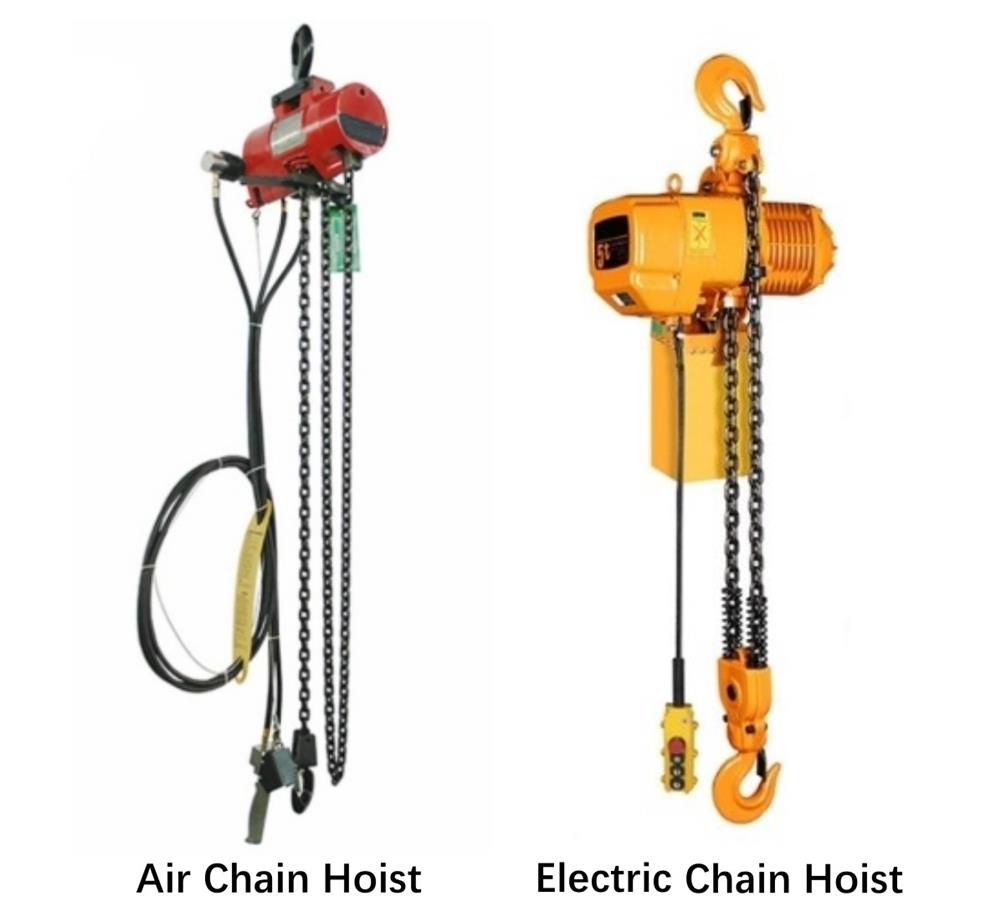Which is Better, Electric Hoist or Air Hoist?
Air hoists (also known as pneumatic hoists) and electric hoists are two types of lifting equipment with different power sources.
Pneumatic hoists utilize air pressure as their power source and typically comprise pneumatic motors, wire ropes, lifting mechanisms, and operating control systems. They are characterized by their simple structure, safety, reliability, and stable operation. These hoists are suitable for special environments such as those with explosion hazards or in damp and corrosive conditions. They find wide application in handling and lifting operations in factories, warehouses, ports, and other locations.
Electric hoists, on the other hand, are powered by electric motors and usually consist of electric motors, wire ropes, lifting mechanisms, control systems, and safety protection devices. They are known for their compact size, light weight, and ease of operation. Electric hoists are extensively used in handling and lifting operations across various settings such as factories, warehouses, and docks, and they are adaptable to diverse working environments.
The following outlines the distinctions between pneumatic hoists and electric hoists in terms of working principles, product performance, and applications.

Working Principles
The working principle of a pneumatic hoist involves driving a pneumatic motor with compressed air, causing it to rotate. This rotation, often transmitted through gear or hydraulic mechanisms, drives the lifting mechanism, enabling the raising or lowering of the load. Operators can adjust movement using a handle or buttons.
In contrast, an electric hoist operates by utilizing an electric motor for its motion. This motor rotation, typically transmitted through gear or hydraulic mechanisms, powers the lifting mechanism to raise or lower the load. Start and stop controls, as well as ascent and descent, can be realized using a remote control.
Product Performance
- Load Capacity: Air hoists generally have a minimum load capacity of 250kg and can handle loads up to 100 tons, while electric hoists typically start at a minimum load capacity of 490kg and have a maximum load capacity of 30 tons.
- Lifting Speed: Typically, the fastest lifting speed of pneumatic hoists is 17m/min, nearly four times faster than electric hoists.
- Precision: Pneumatic hoists offer positioning accuracy at the centimeter level, while modern electric hoists can achieve precision down to the millimeter. Thus, for applications requiring highly accurate positioning, such as in the automotive assembly industry, electric hoists are more suitable.
- Operating Duration: Pneumatic hoists, utilizing air motors, can operate continuously for 24 hours, making them suitable for high-frequency operations without concerns about motor burnout. Electric hoists, powered by electric motors, are more suitable for short-term use as prolonged operation may lead to overheating or motor damage.
- Service Life: The high precision of components in pneumatic hoists makes them suitable for frequent operation, resulting in a longer service life. Conversely, the lower efficiency of electric motors in electric hoists and the susceptibility of many components to wear and tear contribute to a relatively shorter service life.
- Maintenance Costs: While maintenance of air hoists can be conducted by trained non-professionals, regular checks of the compressed air system are necessary to ensure proper functioning. Maintenance of electric hoists requires professional attention, but typically involves less frequent tasks such as regular lubrication and inspection of electrical systems.
- Safety Factor: Air hoists, driven by compressed air, do not generate electric sparks during operation, thus possessing explosion-proof capabilities and higher safety. Electric hoists, driven by electric power, are prone to electrical leakage and electric shock during operation, potentially leading to spark generation and safety hazards.
Applications
Pneumatic hoists, being independent of electrical power, excel in specialized environments such as those with explosion hazards or in damp and corrosive conditions. They find crucial roles in maritime and port operations, where the absence of electrical restrictions allows for efficient cargo lifting and handling aboard ships. Additionally, industries like chemicals and mining, known for their extreme conditions, benefit from the safety features of pneumatic hoists, ensuring smoother operations.

Electric hoists, on the other hand, are indispensable in factory settings and assembly lines, effortlessly facilitating material lifting and intra-facility transportation. Within the realms of warehousing and logistics, they streamline processes by efficiently loading, unloading, and stacking goods, thus enhancing overall operational efficiency. Moreover, in construction sites, electric hoists play a pivotal role in lifting and installing structural components such as steel frameworks and concrete elements, significantly expediting construction tasks.

Besides, electric hoists generally come at a lower price point compared to pneumatic hoists of equivalent specifications. Therefore, unless for specialized applications, choosing an electric hoist is often more economical. ATO provides air hoists with load capacities ranging from 500 pounds to 2,000 pounds and lifting heights from 10 feet to 20 feet, as well as electric hoists with load capacities from 1/4 ton to 10 tons and lifting heights of 10 feet. Feel free to choose according to your specific needs.

